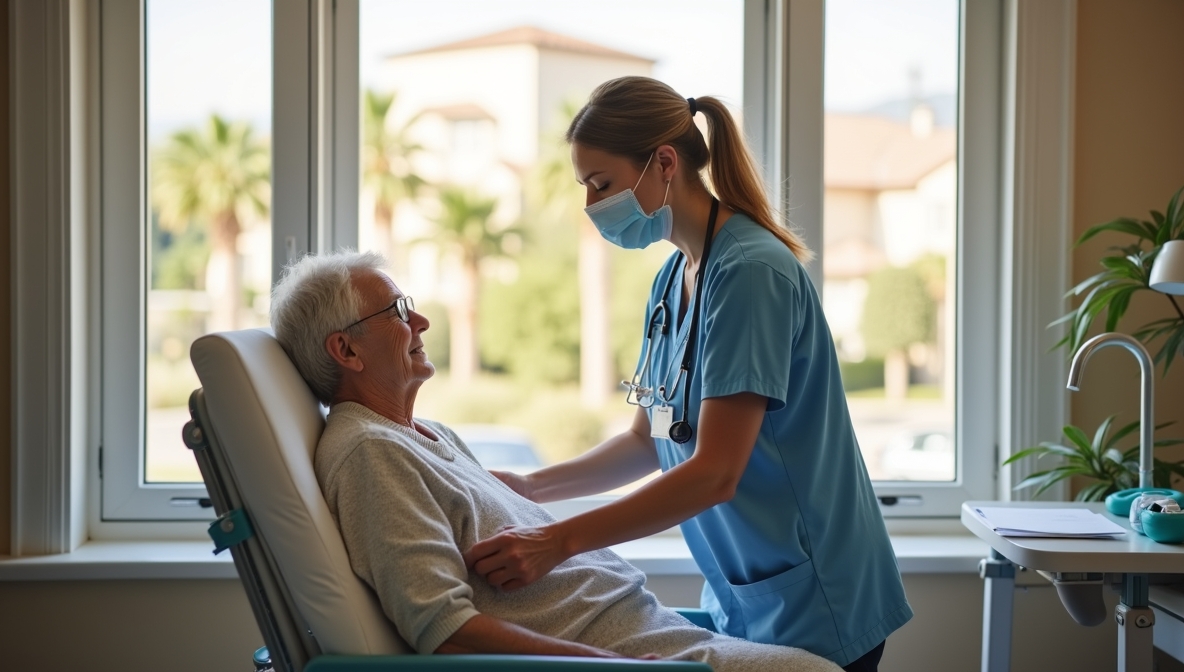California's nursing home employee screening requirements are among the nation's most rigorous, mandated by the California Department of Public Health (CDPH) to protect 1.1 million long-term care residents across 1,100+ facilities. Employers must navigate multi-layered background checks including FBI fingerprinting, criminal history clearances, abuse registry searches, and ongoing monitoring while maintaining strict timeline compliance.
Key Takeaways
- California nursing home employee screening requires CDPH-approved criminal background clearances through Live Scan fingerprinting before any patient contact begins.
- The California long-term care facility staff screening timeline typically ranges from 3-10 business days for initial clearance, though conditional hiring is permitted with supervision restrictions.
- CDPH nursing home licensing requirements mandate checks of five databases: DOJ criminal history, FBI records, state abuse registries, federal exclusion lists, and sex offender registries.
- California nursing home employee fingerprinting process costs approximately $49-$79 per applicant and remains valid for facility-specific employment duration only.
- Facilities must conduct annual rescreening of all employees and maintain documented compliance records for minimum three-year periods during CDPH inspections.
- Non-compliance with California long-term care facility staff screening protocols can result in $25,000+ fines per violation, license suspension, and federal Medicare/Medicaid decertification.
Understanding California Nursing Home Employee Screening Requirements
California's approach to long-term care worker vetting reflects the state's commitment to resident safety. The CDPH Division of Licensing and Certification oversees comprehensive screening protocols extending beyond standard employment verification. These requirements apply to direct care staff, dietary workers, housekeeping personnel, administrative employees, contractors, and volunteers with resident access.
The regulatory foundation stems from California Health and Safety Code sections 1338.2-1338.5, establishing mandatory criminal record review standards. State lawmakers strengthened these provisions following high-profile abuse cases in the early 2010s. Facilities operating without proper employee clearances face immediate deficiency citations that can escalate to civil monetary penalties and closure proceedings.
Who Must Complete Background Screening
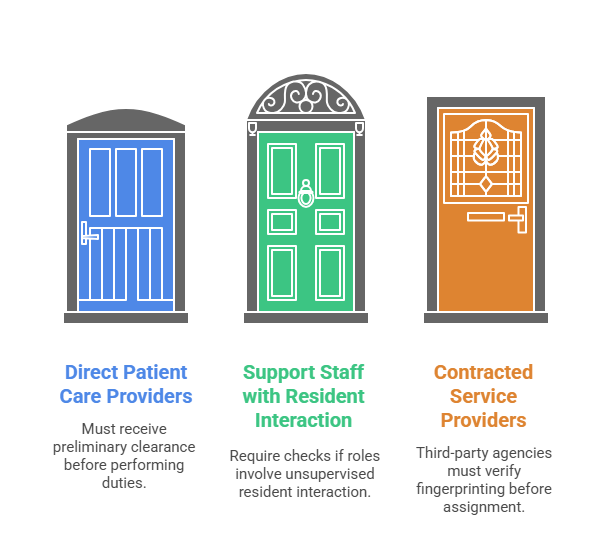
California law distinguishes between employees requiring full background checks before work begins and those eligible for conditional employment during processing. Direct patient care providers—including registered nurses, licensed vocational nurses, certified nursing assistants, and medication technicians—cannot perform duties until receiving preliminary clearance. Support staff such as administrators, social workers, activities coordinators, and maintenance personnel fall under the same requirement if roles involve unsupervised resident interaction.
Contracted service providers represent a commonly overlooked compliance area. Third-party staffing agencies must verify that temporary workers complete California nursing home employee fingerprinting processes before assignment. Facilities retain ultimate responsibility for ensuring contractors, vendors, consultants, and visiting healthcare practitioners meet screening standards during their on-premises time.
CDPH Nursing Home Licensing Requirements: Database Checks
The California Department of Public Health mandates a five-component verification system cross-referencing multiple state and federal databases. Each component serves a distinct protective function. Facilities must document completion of all elements before finalizing any hire.
| Database Component | Search Scope | Processing Time | Validity Period |
| DOJ Criminal History | California convictions and arrests | 3-5 business days | Employment duration |
| FBI Background Check | National criminal records | 5-10 business days | Employment duration |
| State Abuse Registry | CA healthcare worker misconduct | 1-2 business days | Annual reverification |
| Federal Exclusion Lists | Medicare/Medicaid sanctions | Same day | Monthly monitoring |
| Sex Offender Registry | Megan's Law database | Same day | Quarterly verification |
This comprehensive approach ensures no single database gap compromises resident safety.
Criminal History Clearance Process
California nursing home employee screening begins with Live Scan fingerprinting, an electronic submission system capturing biometric data. The system transmits information simultaneously to the California Department of Justice and Federal Bureau of Investigation. Applicants must visit CDPH-approved Live Scan locations with proper identification and the facility-provided request form.
Results flow directly to the facility's designated administrator, not to the applicant. This confidentiality protection aligns with Fair Credit Reporting Act principles while ensuring facilities maintain control over hiring decisions. However, California law prohibits facilities from "sharing" clearances between employers.
Healthcare Fraud and Abuse Registry Verification
Federal law prohibits employing individuals excluded from participating in Medicare, Medicaid, or other federal healthcare programs. The Office of Inspector General maintains the List of Excluded Individuals and Entities (LEIE). Facilities must search this database before hiring and monthly thereafter for all current staff.
State-level abuse registry checks complement federal exclusion lists by identifying healthcare workers with substantiated findings of resident abuse, neglect, or misappropriation. The California Department of Social Services maintains records of certified nursing assistants and home health aides with disciplinary actions. These databases update continuously, making ongoing monitoring essential.
California Nursing Home Employee Fingerprinting Process Step-by-Step
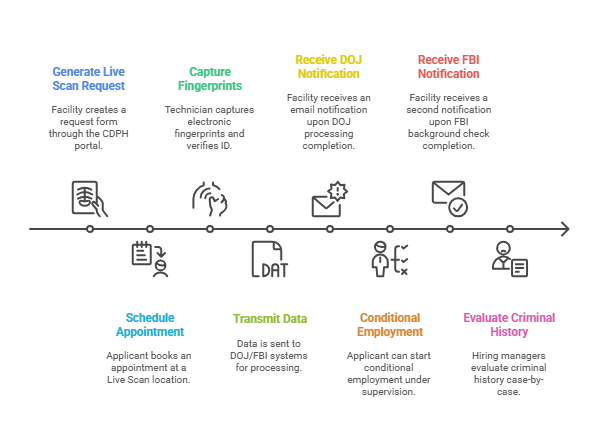
The fingerprinting component represents the most time-intensive element of background verification. Facilities can streamline this process by establishing relationships with high-volume Live Scan providers and creating standardized applicant instruction packets.
The facility generates a Request for Live Scan Service form through the CDPH electronic submission portal, designating the applicant type code and facility's specific ORI number. Next, applicants schedule appointments at participating locations charging fees ranging from $49-$79. The fingerprinting technician captures electronic prints, verifies identification, and transmits data to DOJ/FBI systems.
Facilities receive automated email notifications when DOJ processing completes, typically within three business days. This preliminary clearance permits conditional employment under supervision while FBI results remain pending. FBI background check completion triggers a second notification, usually 5-10 business days post-fingerprinting.
Addressing Disqualifying Offenses
California Health and Safety Code section 1338.5 establishes specific criminal convictions that permanently bar employment in nursing homes. These include violent felonies, sex offenses, elder abuse, dependent adult abuse, and fraud against government healthcare programs. Facilities cannot hire individuals with these convictions regardless of time elapsed.
Other criminal history requires case-by-case evaluation following established legal standards. Hiring managers should consider conviction dates, sentence completion, and multiple offenses versus isolated incidents. Documentation of this analysis protects facilities from discrimination claims while ensuring resident safety remains paramount.
California Long-Term Care Facility Staff Screening Timeline Management
Operational efficiency in nursing homes depends on maintaining adequate staffing ratios while ensuring every employee meets regulatory clearance standards. Savvy administrators build background check processing time into recruitment workflows, accounting for seasonal variations and unexpected delays.
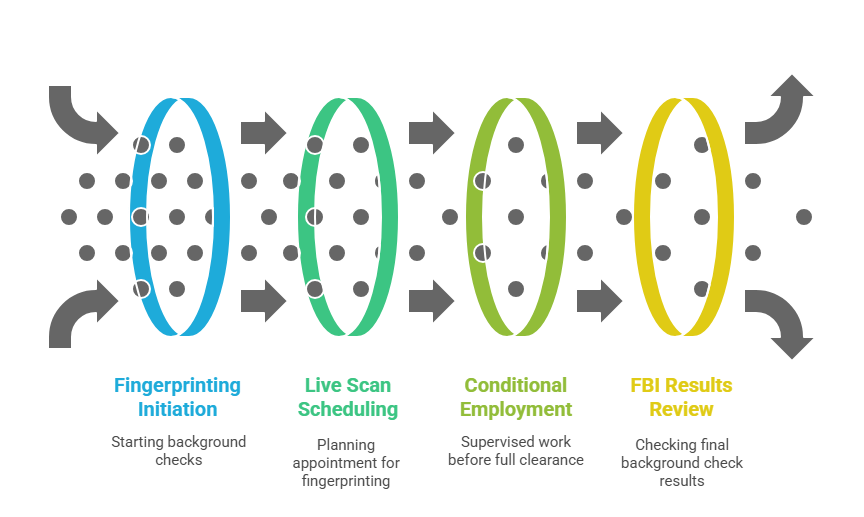
Facilities should initiate fingerprinting immediately after conditional offer acceptance, ideally within 24-48 hours. Pre-scheduling Live Scan appointments as part of the offer process eliminates applicant procrastination and provides concrete start date projections. Some facilities partner with mobile Live Scan providers who visit the facility on designated days.
Conditional Employment Parameters
CDPH regulations permit supervised conditional employment after preliminary DOJ clearance but before FBI results return. However, conditional employment requires specific safeguards: direct line-of-sight supervision by a fully cleared employee, prohibition from medication administration or treatment provision, and documented daily oversight logs.
The conditional employment period cannot exceed 90 days under any circumstances. If FBI results remain pending beyond this timeframe, the facility must suspend the employee from all duties. Facilities should establish clear policies regarding compensation during extended clearance delays.
Ongoing Compliance and Rescreening Requirements
Initial background clearance represents just the beginning of a facility's compliance obligations. CDPH nursing home licensing requirements mandate continuous monitoring and periodic reverification identifying criminal activity, licensing sanctions, or exclusion list additions occurring after hire.
Many administrators schedule these reviews on employment anniversary dates to distribute workload throughout the year. Monthly exclusion list monitoring, quarterly license verification, annual abuse registry checks, and continuous criminal monitoring through commercial services provide automated alerts when employees face new charges.
Record Retention Best Practices
Facilities must maintain background check documentation for three years following employment termination. These records should include original Live Scan receipts, clearance notification emails, database search results with dates, rehabilitation assessments for disclosed convictions, and annual rescreening documentation. Organizing these materials in individual compliance folders facilitates rapid retrieval during CDPH surveys.
Electronic record systems offer advantages over paper filing, including automated retention scheduling and secure access logging. However, facilities using digital storage must ensure systems meet HIPAA security standards and provide adequate backup protection.
Cost Considerations and Budgeting
California nursing home employee screening expenses accumulate quickly in facilities experiencing high turnover rates. The average 200-bed skilled nursing facility processing 150 new hires annually incurs approximately $11,250 in direct fingerprinting costs alone.
| Expense Category | Per-Employee Cost | Annual Cost (150 hires) | Cost-Reduction Strategy |
| Live Scan Fingerprinting | $49-$79 | $7,350-$11,850 | Negotiate volume discounts |
| Commercial Background Services | $25-$50 | $3,750-$7,500 | Bundle services for better rates |
| Staff Processing Time | $35-$60 | $5,250-$9,000 | Implement automated tracking |
Facilities can offset some screening costs by passing certain fees to applicants when legally permissible. California law allows employers to require applicants to pay for fingerprinting services when disclosed upfront and applied consistently.
Common Compliance Pitfalls and How to Avoid Them
CDPH surveys consistently identify background check deficiencies among the most frequent citation categories. These often stem from incomplete documentation rather than actual screening failures.
Facilities frequently assume third-party vendors handle their own employee screening, only to discover during surveys that contracted workers lack proper clearances. Establish written agreements requiring contractors to provide background check verification before any worker enters the facility. Conditional employees working without proper oversight documentation create immediate jeopardy citations. Missing annual rescreening deadlines typically results from inadequate tracking systems. Forgetting to check all five required databases represents a growing citation category.
Responding to Deficiency Citations
Facilities receiving background check citations during CDPH surveys must submit plans of correction within 10 calendar days. These plans should identify the specific deficient practice, explain corrective actions taken, describe systemic changes preventing recurrence, and provide evidence of staff education on proper procedures.
Effective plans of correction demonstrate accountability while highlighting improved compliance infrastructure. Supporting this narrative with specific dates, responsible parties, and measurable outcomes strengthens the submission.
Integrating Background Checks into Hiring Workflows
Seamless California nursing home employee screening requires embedding compliance requirements into every recruitment stage. Forward-thinking facilities view background checks not as administrative burdens but as quality assurance mechanisms protecting residents, staff, and organizational reputation.
During initial job postings, clearly state that employment is contingent upon successful background clearance. This transparency prevents candidate frustration later while demonstrating the facility's commitment to safety standards. Application forms should include disclosure statements allowing the facility to conduct comprehensive screening.
Interview processes provide opportunities to discuss background check requirements and gauge candidate comfort levels. Explain the California nursing home employee fingerprinting process and typical timeline expectations.
Legal Considerations and Employee Rights
California's robust employment protection laws create important guardrails around how facilities use background check information in hiring decisions. The Fair Chance Act prohibits employers from asking about criminal history before making conditional job offers and requires individualized assessments of any convictions disclosed during screening.
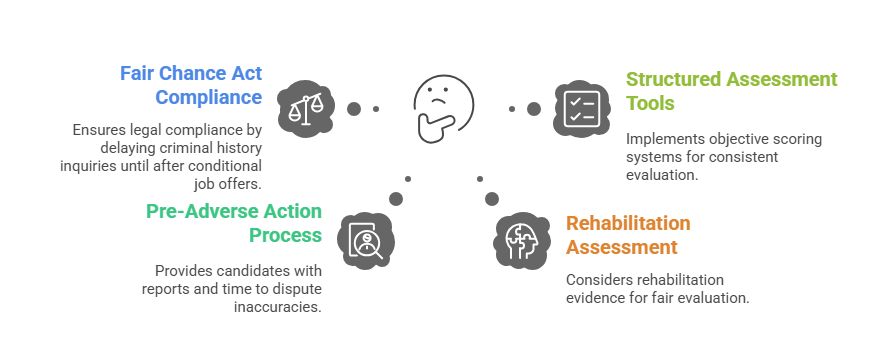
When criminal history appears in background check results, facilities must provide candidates with copies of the reports and written notice of potential adverse action. This pre-adverse action process allows applicants at least five business days to dispute inaccuracies, provide context, or submit rehabilitation evidence.
Rehabilitation Assessment Frameworks
California law requires employers to consider rehabilitation evidence when evaluating convictions that don't fall under automatic disqualification categories. Relevant factors include the nature and gravity of the offense, time elapsed since conviction, the nature of the job sought, evidence of rehabilitation efforts, and employment history since conviction.
Some facilities implement structured rehabilitation assessment tools that assign weighted scores to various factors, creating more objective evaluation processes. Legal counsel review of assessment instruments before implementation helps ensure methodologies withstand regulatory scrutiny.
Special Considerations for Agency and Registry Staff

Staffing agencies and nursing registries supplying temporary workers to California facilities face unique compliance challenges. These organizations must complete full background screening for all healthcare personnel before placement while coordinating with facilities to ensure documentation meets each client's specific requirements.
Agencies should maintain centralized compliance databases tracking each worker's clearance status. Smart agencies provide facilities with comprehensive compliance packets including all five database search results, streamlining the approval process and reducing placement delays.
Facility Responsibilities for Contract Staff
Long-term care facilities retain ultimate regulatory responsibility for ensuring agency staff meet all California nursing home employee screening requirements before beginning work. CDPH surveys examine temporary worker files with the same scrutiny applied to direct employees.
Some administrators mistakenly believe that contracting with licensed staffing agencies transfers background check responsibility entirely to the vendor. This assumption creates dangerous compliance gaps. Facilities must independently verify that agency-provided clearance documentation is current, complete, and meets CDPH standards.
Preparing for CDPH Surveys and Audits
State licensing surveys include mandatory review of employee background check compliance. Surveyors verify that facilities checked all required databases, maintained proper documentation, followed conditional employment protocols correctly, and completed rescreening within required timeframes.
Quarterly internal audits using CDPH survey protocols reveal documentation gaps before surveyors arrive. Mock surveys conducted by external consultants provide objective assessments of compliance readiness.
Documentation Organization Strategies
Surveyors expect to receive requested documentation within minutes during licensing reviews. Organizing compliance files in standardized formats with clear indexing systems facilitates rapid retrieval. Digital document management systems revolutionize survey preparation when properly implemented, allowing administrators to produce requested files instantly during surveys.
Multi-Facility Organizations and Corporate Compliance
Healthcare organizations operating multiple California nursing homes face additional complexity in managing California nursing home employee screening across locations. Centralized tracking systems become essential for monitoring compliance status across the organization.
Multi-site operators benefit from negotiating enterprise-level contracts with background screening vendors, providing cost savings and consistent service quality. However, each individual facility license requires separate CDPH documentation.
Training and Staff Education Requirements
Effective compliance depends on thorough staff education regarding California long-term care facility staff screening requirements. Human resources personnel, hiring managers, and administrators need comprehensive training on proper procedures including Live Scan form generation, conditional employment supervision, rescreening schedules, and documentation standards.
Training should emphasize not just procedural compliance but also the underlying protective purpose of screening requirements. Staff who understand how thorough background checks protect residents, employees, and the facility demonstrate greater attention to detail.
Conclusion
California nursing home employee screening represents a comprehensive regulatory framework designed to protect vulnerable residents through rigorous background verification and ongoing monitoring. Success requires understanding CDPH nursing home licensing requirements, implementing systematic workflows for the California nursing home employee fingerprinting process, maintaining meticulous documentation throughout employment, and staying current with evolving regulatory expectations.
Frequently Asked Questions
How long does the California nursing home employee fingerprinting process take?
The California nursing home employee fingerprinting process typically takes 7-14 business days from Live Scan appointment to final FBI clearance. The DOJ usually processes state criminal history within 3-5 business days, providing preliminary clearance for supervised conditional employment.
What criminal convictions permanently disqualify someone from nursing home employment in California?
California Health and Safety Code section 1338.5 permanently bars individuals with specific convictions including violent felonies, sex offenses, elder abuse, dependent adult abuse, child abuse, and fraud against Medicare/Medicaid programs. Other criminal history requires individualized assessment considering offense nature, time elapsed, and rehabilitation efforts.
Can nursing homes share background check results between facilities when employees transfer?
No, California law requires each nursing home to conduct independent background screening even when hiring employees who recently worked at other long-term care facilities. Employees moving between facilities must complete the entire California nursing home employee screening process again.
What are the rescreening requirements for current nursing home employees in California?
CDPH nursing home licensing requirements mandate annual rescreening of all employees through the same five databases checked during initial hire. Monthly monitoring of OIG and state Medicaid exclusion lists is required for all current staff.
How much does California nursing home employee screening cost per applicant?
California nursing home employee screening costs range from $74-$129 per applicant. Live Scan fingerprinting fees typically run $49-$79, while commercial background screening services cost $25-$50 per applicant.
What happens if an employee's background check reveals criminal history after they're already working?
When annual rescreening reveals new criminal charges or convictions, facilities must immediately assess the situation following Fair Chance Act protocols. Employees should be suspended from resident contact duties pending investigation and individualized assessment.
Do volunteers and contractors need the same background checks as employees?
Yes, California regulations require identical background screening for volunteers, contractors, vendors, and any individuals with unsupervised resident access. Contracted staffing agencies must provide complete background check documentation before workers begin shifts.
What should facilities do when FBI background checks are delayed beyond 90 days?
California permits conditional employment for a maximum of 90 days while awaiting FBI results, after which employees must be suspended from all duties if clearance hasn't arrived. Facilities should contact the Live Scan provider and DOJ to investigate delays exceeding 60 days.
Additional Resources
- California Department of Public Health - Skilled Nursing Facilities Licensing Requirements
https://www.cdph.ca.gov/Programs/CHCQ/LCP/Pages/LNCSKLD.aspx - California Health and Safety Code Section 1338.2-1338.5 - Background Check Requirements
https://leginfo.legislature.ca.gov/faces/codes_displaySection.xhtml?lawCode=HSC§ionNum=1338.2 - California Department of Justice - Live Scan Information and Locations
https://oag.ca.gov/fingerprints/locations - Office of Inspector General - List of Excluded Individuals and Entities (LEIE)
https://oig.hhs.gov/exclusions/ - California Department of Social Services - Nurse Aide Registry Verification
https://secure.dss.cahwnet.gov/cnac/ - CDPH Licensing and Certification Program - Survey and Enforcement Information
https://www.cdph.ca.gov/Programs/CHCQ/LCP/Pages/LE.aspx - California Civil Rights Department - Fair Chance Act Employer Guidance
https://calcivilrights.ca.gov/fair-chance-act/ - Centers for Medicare & Medicaid Services - Background Checks for Long-Term Care Facilities
https://www.cms.gov/Medicare/Provider-Enrollment-and-Certification/SurveyCertificationGenInfo/LTC-CMS-Guidance
Still have questions?
Get in touch with our team today for a personalized demo and discover how our tailored volume pricing and packages can drive results for your business!
How useful was this page?*
Note: your comments are anonymous. We use them to improve the website. Do not include any personal details.
Visit our FCRA Compliance Tool or leave a message here if you need a response.
From the blog Explore the GCheck Content Hub

How Long Does a Background Check Take? A Complete 2025 Guide
13 Dec, 2023 • 14 min read
The Ultimate Background Check Guide
13 Dec, 2023 • 4 min read
The Ultimate Guide to Employment Background Checks
13 Dec, 2023 • 10 min readThe information provided in this article is for general informational and educational purposes only and should not be construed as legal advice or a substitute for consultation with qualified legal counsel. While we strive to ensure accuracy, employment screening laws and regulations—including but not limited to the Fair Credit Reporting Act (FCRA), Equal Employment Opportunity Commission (EEOC) guidelines, state and local ban-the-box laws, industry-specific requirements, and other applicable federal, state, and local statutes—are subject to frequent changes, varying interpretations, and jurisdiction-specific applications that may affect their implementation in your organization. Employers and screening decision-makers are solely responsible for ensuring their background check policies, procedures, and practices comply with all applicable laws and regulations relevant to their specific industry, location, and circumstances. We strongly recommend consulting with qualified employment law attorneys and compliance professionals before making hiring, tenant screening, or other decisions based on background check information.
